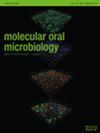Streptococcus mutans cell division protein FtsZ has higher GTPase and polymerization activities in acidic environment.
IF 2.8
3区 医学
Q1 DENTISTRY, ORAL SURGERY & MEDICINE
引用次数: 1
Abstract
The acid tolerance of Streptococcus mutans plays an important role in its cariogenic process. S. mutans initiates a powerful transcriptional and physiological adaptation mechanism, eventually shielding the cellular machinery from acid damage and contributing to bacterial survival under acidic stress conditions. Although S. mutans contains complex regulatory systems, existing studies have shown that S. mutans, unlike Escherichia coli, cannot maintain a neutral intracellular environment. As the pH of the extracellular environment decreases, the intracellular pH decreases in parallel. There is insufficient knowledge regarding the acid resistance of the intracellular proteins of S. mutans, particularly when it comes to the key cytoskeletal division protein FtsZ. In this study, the data showed that S. mutans had similar cell division progress in acidic and neutral environments. The splitting position was in the middle of cells, and the cytoplasm were divided evenly in the acidic environment. Additionally, the treadmilling velocity of S. mutans FtsZ in the middle of cells was not affected by the acidic environment. S. mutans FtsZ had higher GTPase activity in pH 6.0 buffer than in the neutral environment. Furthermore, the polymerization of S. mutans FtsZ in the acidic environment was more robust than that in the neutral environment. After two particular amino acids of S. mutans FtsZ amino acids were mutated (E88K, L269K), the polymerization of S. mutans FtsZ in the acidic environment was significantly reduced. Overall, S. mutans FtsZ exhibited higher functional activity in pH 6.0 buffer in vitro. The acid resistance of S. mutans FtsZ is affected by its particular amino acids. This article is protected by copyright. All rights reserved.变形链球菌细胞分裂蛋白FtsZ在酸性环境中具有较高的GTPase和聚合活性。
变形链球菌的耐酸性在其致龋过程中起着重要作用。变形链球菌启动了一种强大的转录和生理适应机制,最终保护细胞机制免受酸损伤,并有助于细菌在酸性胁迫条件下生存。尽管变异链球菌含有复杂的调控系统,但现有研究表明,变异链球菌与大肠杆菌不同,不能维持中性的细胞内环境。当细胞外环境的pH值降低时,细胞内pH值平行降低。关于变形链球菌细胞内蛋白的耐酸性,尤其是当涉及到关键的细胞骨架分裂蛋白FtsZ时,还没有足够的知识。在这项研究中,数据表明变形链球菌在酸性和中性环境中具有相似的细胞分裂过程。分裂位置在细胞中间,细胞质在酸性环境中分裂均匀。此外,变异链球菌FtsZ在细胞中间的踩踏速度不受酸性环境的影响。变形链球菌FtsZ在pH6.0的缓冲液中具有比在中性环境中更高的GTPase活性。此外,变形链球菌FtsZ在酸性环境中的聚合比在中性环境中的更稳定。变异链球菌FtsZ的两个特定氨基酸(E88K、L269K)发生突变后,变异链球菌FstsZ在酸性环境中的聚合作用显著降低。总的来说,变异链球菌FtsZ在pH 6.0的缓冲液中表现出更高的体外功能活性。变形链球菌FtsZ的耐酸性受其特定氨基酸的影响。这篇文章受版权保护。保留所有权利。
本文章由计算机程序翻译,如有差异,请以英文原文为准。
求助全文
约1分钟内获得全文
求助全文
来源期刊

Molecular Oral Microbiology
DENTISTRY, ORAL SURGERY & MEDICINE-MICROBIOLOGY
CiteScore
6.50
自引率
5.40%
发文量
46
审稿时长
>12 weeks
期刊介绍:
Molecular Oral Microbiology publishes high quality research papers and reviews on fundamental or applied molecular studies of microorganisms of the oral cavity and respiratory tract, host-microbe interactions, cellular microbiology, molecular ecology, and immunological studies of oral and respiratory tract infections.
Papers describing work in virology, or in immunology unrelated to microbial colonization or infection, will not be acceptable. Studies of the prevalence of organisms or of antimicrobials agents also are not within the scope of the journal.
The journal does not publish Short Communications or Letters to the Editor.
Molecular Oral Microbiology is published bimonthly.
 求助内容:
求助内容: 应助结果提醒方式:
应助结果提醒方式:


